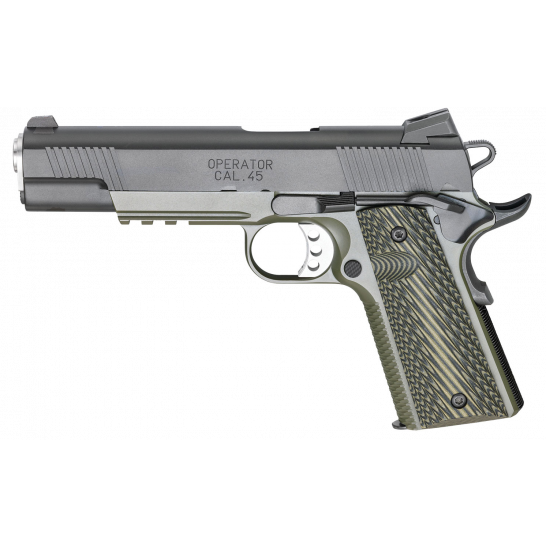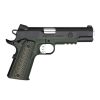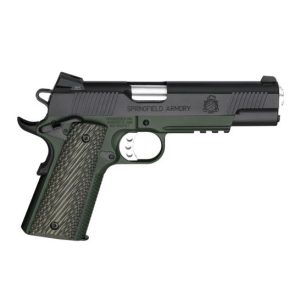Springfield 1911 MC Operator .45ACP Pistol – PX9110ML For Sale
$1,149.99
The Springfield 1911 MC Operator .45ACP Pistol – PX9110ML, part of the revered Loaded Series from Springfield Armory®, exemplifies the harmonious blend of traditional 1911 design with modern enhancements. Designed for those who value the legendary reliability of the 1911 but desire contemporary improvements, this pistol features an extended ambidextrous thumb safety for easy use by both right and left-handed shooters, making it suitable for target practice or home defense. The ergonomic beavertail grip safety, lightweight delta hammer, and extended trigger ensure superior comfort, control, and a smooth firing experience. Unlike typical 1911 models, the MC Operator offers numerous customizable features and finishes, eliminating the need for custom shop modifications and catering to a variety of preferences and shooting applications. Ultimately, the Springfield 1911 MC Operator stands out as an exceptional value, blending historical craftsmanship with modern refinements.
What 1911 does the Marine Corps use?
The Marine Corps uses a variant of the M1911 pistol known as the M45A1. This is a modernized version of the classic M1911 design, tailored to meet the needs of the Marines.
Is Springfield Operator good?
I don’t have specific information on an entity or person named “Springfield Operator.” To determine if they are “good,” you might consider looking at reviews, testimonials, or any relevant reputation metrics associated with their services or performance.
Did the military use Springfield 1911?
Yes, the military used the M1911, which is a .45 caliber semi-automatic pistol. It was designed by John Browning and was officially adopted by the United States Armed Forces in 1911. Springfield Armory was one of the manufacturers that produced M1911 pistols for military use during World War I and World War II. The M1911 remained the standard-issue sidearm for the U.S. military until it was replaced by the Beretta M9 in 1985.
Are springfield 1911s forged or cast?
Springfield 1911 pistols are generally known for having forged frames and slides. This is often emphasized as a feature for strength and durability. However, it’s always a good idea to check specific models or current manufacturing processes directly from Springfield Armory, as production techniques can evolve.
What 1911 do special forces use?
Special forces units, particularly those in the United States, have used the M1911 pistol at various times. The particular models often favored by these units include the Colt M1911A1 or custom versions like the MEU(SOC) pistol used by the Marine Expeditionary Units. These custom versions are typically based on the classic M1911 design but modified for reliability, durability, and performance according to the specific demands of the mission and the preferences of the operators.
What gun does USMC infantry use?
The primary firearm used by the United States Marine Corps infantry is the M27 Infantry Automatic Rifle (IAR). This weapon is part of the Heckler & Koch HK416 family and has replaced the M249 light machine gun in many roles within the infantry. In addition to the M27, Marines also use the M16A4 rifle and the M4 carbine for various purposes.
Is Springfield Armory out of business?
No, Springfield Armory is not out of business. The company continues to operate and manufacture firearms.
What does TRP stand for in Springfield Armory?
In the context of Springfield Armory, TRP stands for “Tactical Response Pistol.”
Who makes guns for Springfield Armory?
Springfield Armory, Inc. is an American firearms manufacturer and importer. It designs and manufactures its own firearms. Some of its popular products include the XD series of pistols, which were originally based on a design by the Croatian company HS Produkt, and the M1A rifle, which is based on the U.S. military’s M14 rifle. Springfield Armory’s manufacturing operations take place in the United States.
What 1911 does the FBI use?
The FBI has used the Springfield Armory Professional Model 1911 as part of its inventory, particularly for its Hostage Rescue Team and Special Weapons and Tactics (SWAT) teams. This .45 ACP pistol is customized to meet the specific requirements of the FBI’s tactical units.
What is the difference between the 1911 and the 1911a1?
The primary differences between the original M1911 and the M1911A1, which were refinements introduced in the 1920s, are as follows:
1. **Backstrap**: The M1911A1 has a longer, arched mainspring housing compared to the straight one on the original M1911. This change was intended to improve grip and shooting ergonomics.
2. **Trigger**: The trigger on the M1911A1 is shorter, and there are relief cuts on the frame behind the trigger to better accommodate various hand sizes and provide a more comfortable grip.
3. **Grip Safety**: The M1911A1 has an extended beavertail on the grip safety to help prevent “hammer bite,” which happens when the web of the hand is pinched by the hammer during recoil.
4. **Front Sight**: The M1911A1 features a higher front sight to provide better sight alignment and visibility.
5. **Hammer**: The spur on the hammer was shortened on the M1911A1 to further reduce the risk of “hammer bite.”
6. **Thumb Safety and Magazine Catch**: These were slightly modified to provide easier operation.
Overall, the changes made in the M1911A1 were aimed at enhancing user comfort and usability, without altering the basic mechanics and reliability of the original M1911 design.
What is the rarest 1911 pistol?
The rarest 1911 pistol is often considered to be the Singer Model 1911A1. During World War II, the Singer Sewing Machine Company produced a highly limited run of 500 units under a U.S. government contract. These pistols are extremely rare and highly sought after by collectors due to their scarcity and historical significance.
Are Springfield 1911 made in USA?
Yes, Springfield 1911 pistols are manufactured in the United States. Springfield Armory produces them in Geneseo, Illinois.
How do I know if I have forged or cast?
To determine if a metal part is forged or cast, you can consider the following differences:
1. **Surface Appearance**:
– *Forged Parts*: Typically have a smoother surface with visible marks from the forging process, such as seams or lines where the metal was compressed.
– *Cast Parts*: Often have a rougher surface with small imperfections or visible signs of molding, like parting lines from the mold.
2. **Sound**:
– *Forged Parts*: Generally produce a clearer, ringing sound when struck, due to the denser material structure.
– *Cast Parts*: Tend to produce a duller sound because of potential air pockets and a less dense microstructure.
3. **Weight**:
– *Forged Parts*: May feel heavier per volume due to the compaction and alignment of the metal grains.
– *Cast Parts*: Can be lighter if there are internal voids or less material density.
4. **Grain Structure**:
– *Forged Parts*: Have a more uniform and aligned grain structure, resulting in better mechanical properties such as toughness and fatigue resistance.
– *Cast Parts*: Display a more disorganized grain structure and may include internal porosity or inclusions.
5. **Strength and Durability**:
– *Forged Parts*: Usually stronger and more durable due to the forging process aligning the grains and removing imperfections.
– *Cast Parts*: While they can be strong, they are more prone to imperfections such as shrinkage voids and non-metallic inclusions.
6. **Cost and Complexity**:
– *Forged Parts*: Generally more expensive due to the labor-intensive process and the need for specific dies, but they offer precise mechanical properties.
– *Cast Parts*: Often cheaper and easier to produce for complex shapes, particularly in large quantities.
7. **Applications**:
– Consider where the part is used. Forged parts are often used in high-stress applications (e.g., aerospace, automotive parts), whereas cast parts might be used where complex shapes are required without needing extreme strength (e.g., ornamental applications).
By examining these characteristics, you can usually determine whether a part is forged or cast. If still in doubt, consider consulting a metallurgist or using advanced analysis techniques such as X-ray or metallographic examination.
Do all 1911s take the same mags?
Not all 1911s take the same magazines. While many 1911 pistols have similar magazine designs due to their common origin, variations in size, caliber, and manufacturer can result in differences. Full-size 1911s typically use standard 7 or 8-round magazines for .45 ACP, but 1911s chambered in other calibers, such as 9mm or .38 Super, require magazines specifically designed for those rounds. Additionally, compact and subcompact 1911 models have shorter frames, necessitating shorter magazines. Always check the specific magazine compatibility for your 1911 model and caliber.
| Sights | Low Profile Combat, 3 – Dot Tritium |
|---|---|
| Overall Length | 8.6" |
Be the first to review “Springfield 1911 MC Operator .45ACP Pistol – PX9110ML” Cancel reply
Related products
Springfield 1911 MC Operator



Reviews
There are no reviews yet.